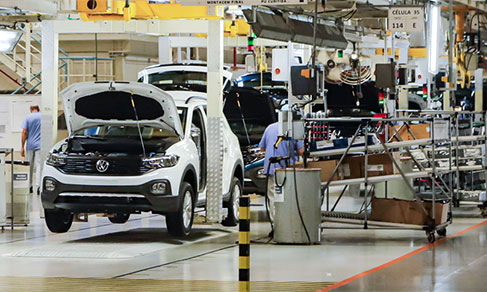PAC
Trade loses 11% of its companies and 4.4% of the workers in five years
July 29, 2021 10h00 AM | Last Updated: July 31, 2021 02h27 AM
Highlights
- Between 2014 and 2019, trade lost 11% of its companies and 4.4% of the workers and 8.1% of the shops.
- Retail, a segment that employed 74.2% of the workers in commercial activities, lost 4.1% of its employed population in the same period of five years.
- In 2019, among the 10.2 million workers in trade, 7.5 were in retail, 1.7 million in wholesale and 908.0 thousand, in trade of vehicles, pieces and motorcycles.
- in relation to 2010, the employed population increased by 12.5%. retail was the segment employing most persons, with a total of 931.2 thousand job posts being created
- In 2019, 1.6 million shops and 1.4 million companies lhad gross revenue of R$ 4.4 trillion and trade margin of R$ 864.3 billion.
- In nine years, trade margin rate went from 27.6% to 28.8%.
- In 2019, the Southeast paid the highest average salary among the Major Regions (2.0 minimum wages) and the Northeast, the lowest (1.4 minimum wages).

Between 2010 and 2019, trade lost 177.3 thousand companies (-11%), 466.1 thousand workers (-4.4%) and 140.6 thousand shops (-8.1%). Retail, responsible for 74.2% of the persons employed in the sector in the commercial segment, faced a decrease of 4.1% in employment. As a result, trade employed, in 2019, 10.2 million workers, being 908.0 thousand in trade of vehicles, pieces and motorcycles, 1.7 million in wholesale trade and 7.5 million in retail trade. Data can be found in the Annual Survey of Trade (PAC) 2019, released today by the IBGE.
The Analysis and Dissemination Manager, Synthia Santana, explains that the loss in trade in this five-year period is related to the context of economic crisis experienced in the country. “the sector of trase, especially retail trade, depends significantly on the country’s domestic consumption. During periods of crisis, we see, in several macroeconomic indicators, a relationship between the decrease in the retail trade sector and unemployment indicators in the country, drop in consumption and indebtedness,” she explains.
Nevertheless, in comparison with 2010, the employed population in trade increased by 12.5%. The segment employng most persons in this period was retail trade, with an increase of 931.2 thousand workers (or 14.1% more). Among the activities, the main highlight, in absolute figures, is the sector of hypermarkets and supermarkets, with 420.0 thousand workers more, representing 45% of this increase in trade.
“There is a ripple effect: when the sector is bigger, it is easier to increase the number of workers. In the case of hypermarkets and supermarkets, there is also a change in the sector itself, which tends to expand the size of these companies. The establihsments that have been part of other activities and services and this increase requires a bigger volume of employed persons”, says the researcher.
On the other hand, the main decrease in occupation, in absolute figures, was registered by trade of computer and communication material and articles for domestic use. The number of job posts was reduced by 6.1% in nine years, or -57.1 thousand.
“There is a decrease in the number of persons employed in companies that sell, mostly, computer products, such as PC’s and communication and other articles. In this period, technological changes may have caused changes in the type of product sold by them,”Ms. Santana says.
According to the researcher, with these changes, some smaller stores started to serve more specific niche. “Electronic and computer products started to be sold by other segments too, such as major chains of supermarkets and home products shops. So smaller establishments try to find more efficient ways of trading, which may require fewer workers in shops.”
Another significant decrease took place in the sector of motor vehicles, which lost 12.0% of employment positions in nine years (or -33.8 thousand job posts). “This loss is as big in absolute terms and in relative terms, that is, in comparison with the size of the sector itself. This activity has undergone successive crisis since 2010 and, in the most recent period, has counting on governmental aid and on other policies in order to keep companies active,” Ms. Santana says.
In comparison with 2018, there was a decrease in employment (-0.4%) and in the number of companies (-5.0%) and in shops (-3.0%) in trade. Against 2010, there was a decrease by 106.3 thousand. Retail trade lost, in ine years, 11.1% of the companies and trade of vehicles, pieces and motorcycles, 3.6%. The number of companies in wholesale increased by 21.5%.
Wholesale accounted for 45.2% of the revenue of trade
In 2019, there were, in the country, 1.6 million shops and 1.4 million companies, which recorded a gross revenue of R$ 4.4 trillion. Among those, R$ 423.1 billion came from trade of vehicles, pieces and motorcycles, R$ 2.0 trillion, in wholesale trade, and R$ 2.0 trillion, in retail.
When deductions, such as taxes and cancellings, are disregarded, the result if net operating revenue, approximately R$ 4.0 trillion. Most of that value came from wholesale trade (45.2%), followed by retail trade (44.9%) and trade of vehicles, pieces and motorcucles (9.9%). That is the first time in five years that wholesale exceeds retail in terms of contribution to revenue.
“The advance of wholesale is still limited and the difference among the sectors, very small. Retail is the sector that employs most person, with great volume and the fact wholesale has surpassed that figure indicates more gains on the margin. Direct sales to companies, without access to thw final consumer, also includes foreign trade, and that explains this increase in wholesale in the last few years,”the manager says.
Three activities were responsible for about one third of the net operating revenu generated in 2019: hypermarkets and supermarkets (12.9%); wholesale trade of fuels and lubricants (11.7%) and retail trade of fuels and lubricants (8.4%).
“In the last few years, the contribution of hypermarkets and supermarkets decreased, but, between 2010 and 2019, that was the sector with biggest advances in terms of contribution to revenue. That is a sector that has been recording increase in terms of compensation, revenue, net operating revenue, employed persons and number of establishments. This advance has to do with the market nich: there is the possibility of exploring, in one same establishments, a variety of products.”
Sector of fabric and wearing apparel has highest trade margin
Trade margin (difference between the net revenue of sales and ths cost of goods sold) was R$ 864.3 billion in 2019. Retail was responsible for 56.1% of the total. Wholesale accounted for 36.4% and trade of vehicles, pieces and motorcycles, for 7.5%. “This is a very important parameter for the trader to decide if it is profitable to remain in the market,” the manager explains.
The trade margin rate is the division of the trade marging by the cost of goods sold. This indicator shows how much each sector can define its net operating revenue of sales above their costs with the acquisition og goods and change of stocks. “It indicates how much the company can set the price above the costs of resale. It is not a profit indicator, but of profitability of the commercial operation. Sectors with a higher margin, in terms of percentage, can determine the price at higher levels than the sectors in which competition is bigger and products, more homogeneous,” says Ms. Santana.
In nine years, this indicator went from 27.6% to 28.8%. Six of the nine segments of retail recorded trade margin rates above 50%. Among the 22 commercial activities, the segment of retail trade of vehicles, wearing apparel and haberdashary remained as the leader with the highest trade margin (81.8%), followed by retail trade of cultura, recreational and sporting articles (65.5%) and retail trade of new and used products without specification (58.7%).
“The highest rate in activities that sell products such as fabric, cultural and sporting articles resulted from their own diversity: these are very general items between one establishment and the other. That causes the company to set prices above the costs of sale and then reach more profitability in the sale of these products,” says the manager.
Northeast pays the lowest average salary
In 2019, the Southeast paid the highest average salary (2.0 minimum wages), followed by the South (both paying 1.8 minimum wages) and by the Northeast (1.4 minimum wages). The Northeast Region paid the lowest: 1.4 minimum wages. This Major Region also lost participation (-0.4 p.p.) in relation to the salary distribution of Major regions in nine years. On the average, commercial companies paid 1.9 minimum wages to their employees in 2019.
“The Northeast had the lowest average salary among the Major Regions in the country, so, below the national average. This result is a consequence of predominant activities in this Major Region. In all the Northeastern states, except for maranhão, there is a predominance of retail trade, a commercial segment in which salaries are lower,” Synthia says.
In relation to the participation in gross sales revenue, the Southeast was responsible for 50% of the total. Although the Major Region is still the leader in the ranking, the Major Region’s participation fell against 2010, when it concentrated 52.4% of the revenue. From 2010 to 2019, the South changed from 19.5% to 20.8%, and the Central West, from 9.1% to 10.3%.
The Southeast was responsible for almost half (49.6%) of the local branches in 2019, but also lost participation (-0.3 p.p.) in the last ten years of the survey. The Central West increased its contribution by 0.6 p.p in the period.
Most of the employment in trade in the country is in the Southeast, which, in 2019, concentrated 51.9% of the total, and increased its contribution (0.5 p.p.) against 2010. The South recorded the biggest decrease in participation (-0.5 p.p).
More on the survey
PAC has been conducted by the IBGE since 1996 and deals with structural aspects of the trade sector in the country. Information in this survey is significant for the analysis and planning of companies of the private sector and of the different levels of governmental. Every year, PAC presents the main results of Brazilian trade companies, which are divided into three segments: trade of vehicles, pieces and motorcycles; wholesale trade; and retail trade. In order to identify structural changes, there is a comparison between results of a series in ten years. Results are available for Brazil, Major Regions and Federation Units.




















